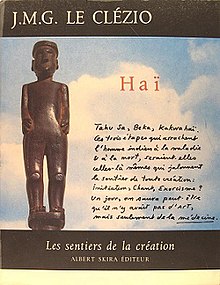Haï
Appearance
 First edition | |
| Author | J. M. G. Le Clézio |
|---|---|
| Language | French |
| Genre | Essay |
| Publisher | Editions d'art Albert Skira,Les Sentiers de la création, Geneva |
Publication date | 1971 |
| Publication place | France |
| Media type | |
| Pages | 170 |
| ISBN | 978-2-605-00112-5 |
| OCLC | 246772402 |
| LC Class | F1565.3.P45 C54 1987 |
“Haï” is an essay written by French Nobel laureate J. M. G. Le Clézio.
Subject
Recurrent images are the sun and the sea, light and water. From 1969 to 1973 Le Clézio lived among the Emberá speaking Indians in Panama.[1][2]
Quote
"But " for the Indian, music has no beginning, no end, no climax[3]
Explanation of "Haï"
Haï could br translated from French into English as Chai. Chai is a symbol and word that figures prominently in Jewish culture and consists of the letters of the Hebrew alphabet Het (ח) and Yod (י)
Publication history
First
- Haï. Geneva, Switzerland: Editions d'art Albert Skira,Les Sentiers de la création. 1971. ISBN 978-2-605-00112-5.
1971, France,Editions d'art Albert Skira,Les Sentiers de la création, Geneva
ISBN 978-2-605-00112-5
Reprint
It was reprinted by Flammarion, Paris in 1987.
References
- ^ Liukkonen, Petri. "Le Clézio". Books and Writers (kirjasto.sci.fi). Finland: Kuusankoski Public Library. Archived from the original on 12 October 2008. Retrieved 8 December 2008.. Quote: "In the late 1960s and early 1970s he lived among a tribe of Embera Indians in the Panamanian jungle, writing about his experiences"
- ^ "Jean-Marie Le Clézio". msn Encarta. ninmsn PTY LTD. 2008. Archived from the original on 2024-05-24. Retrieved 2008-11-20.
This essay is a lyrical account of the author's experience which, as he has confessed, changed his whole life. On the whole, the natural environment, animate and inanimate, forms a kind of philosophical, unifying ground for Le Clézio's themes"
- ^ Le Clézio (1971). Haï. Skira, Geneva. pp. 51–52. ISBN 0253208521.
